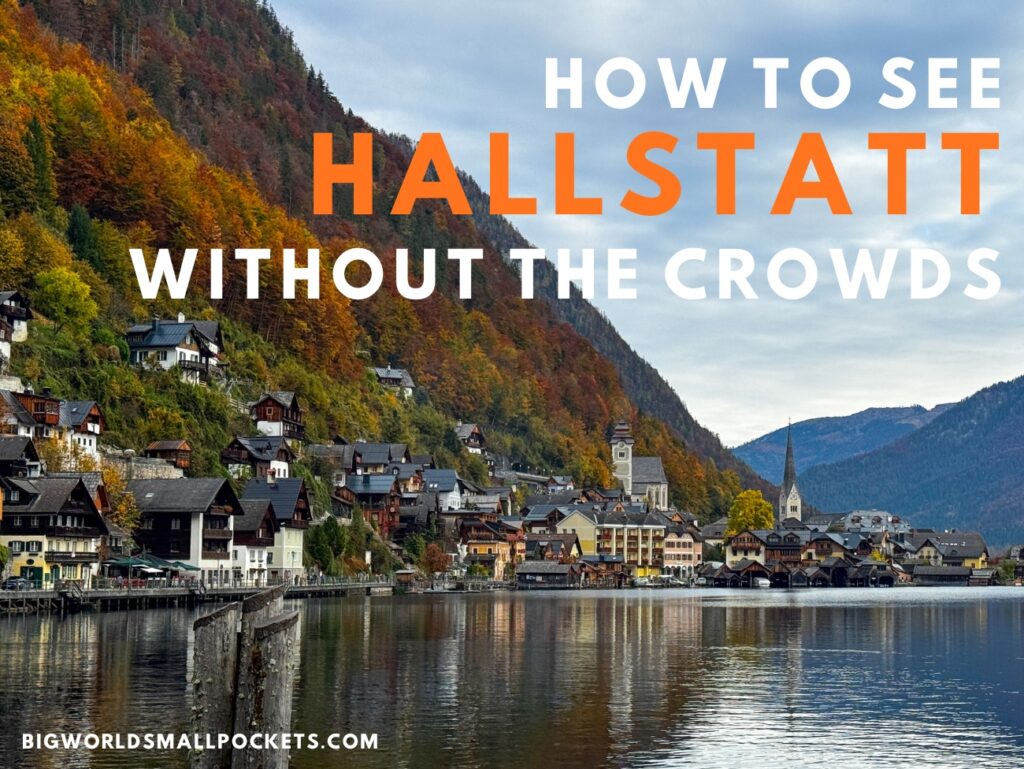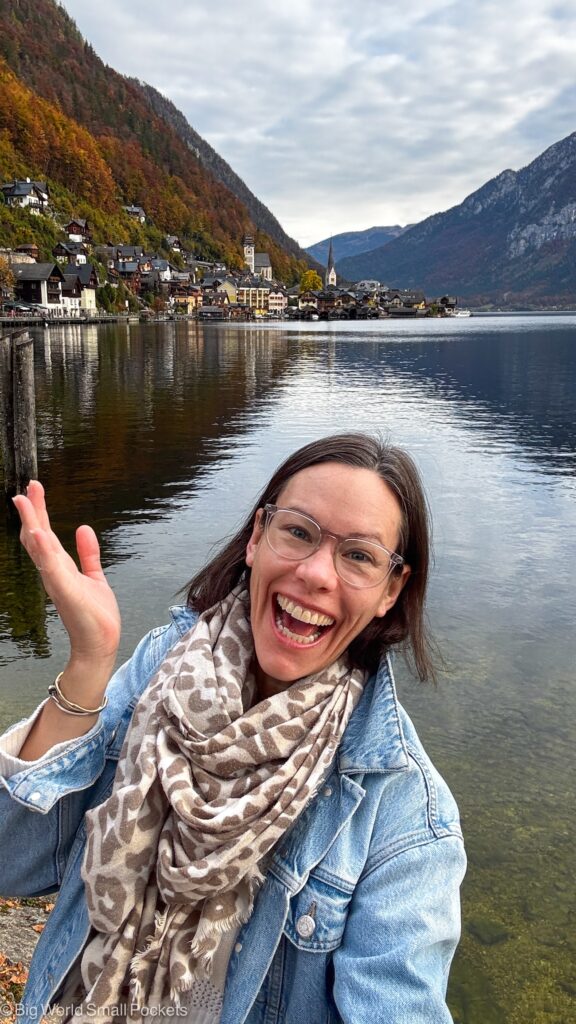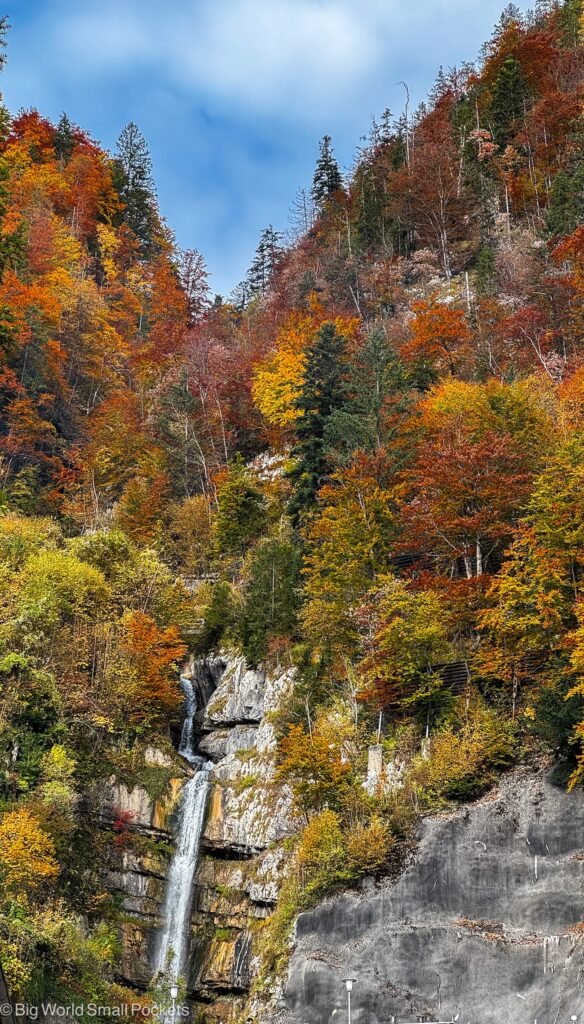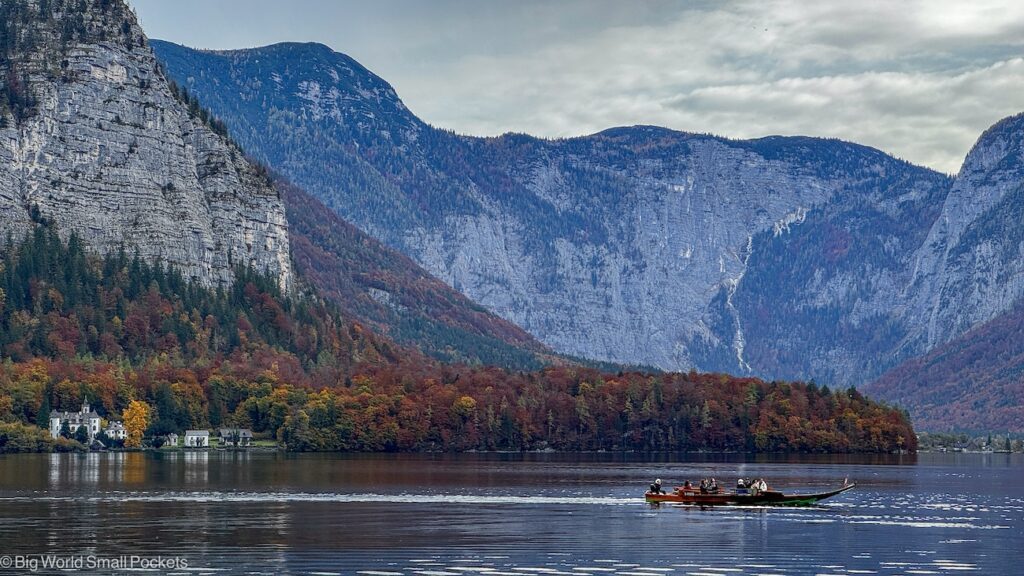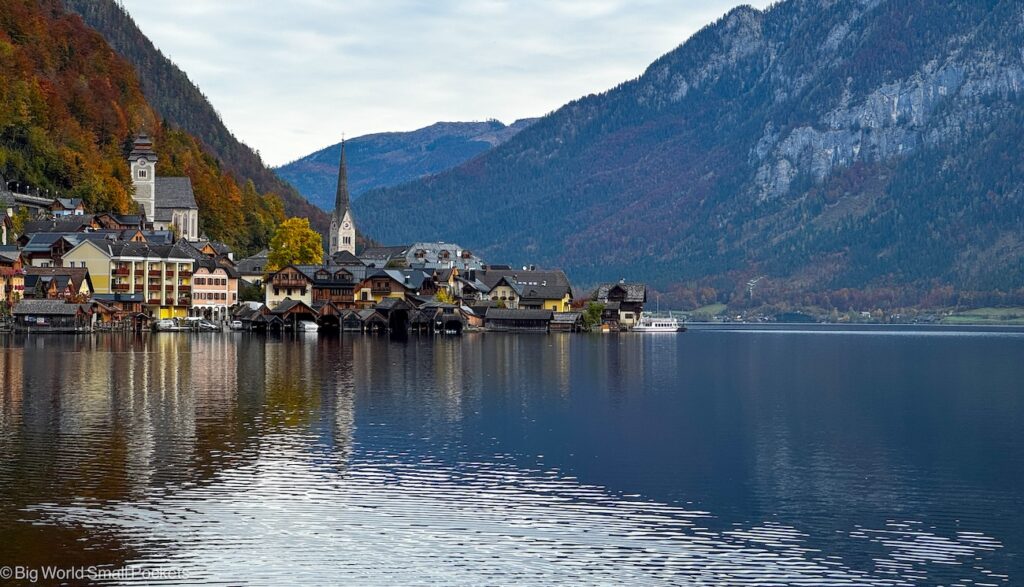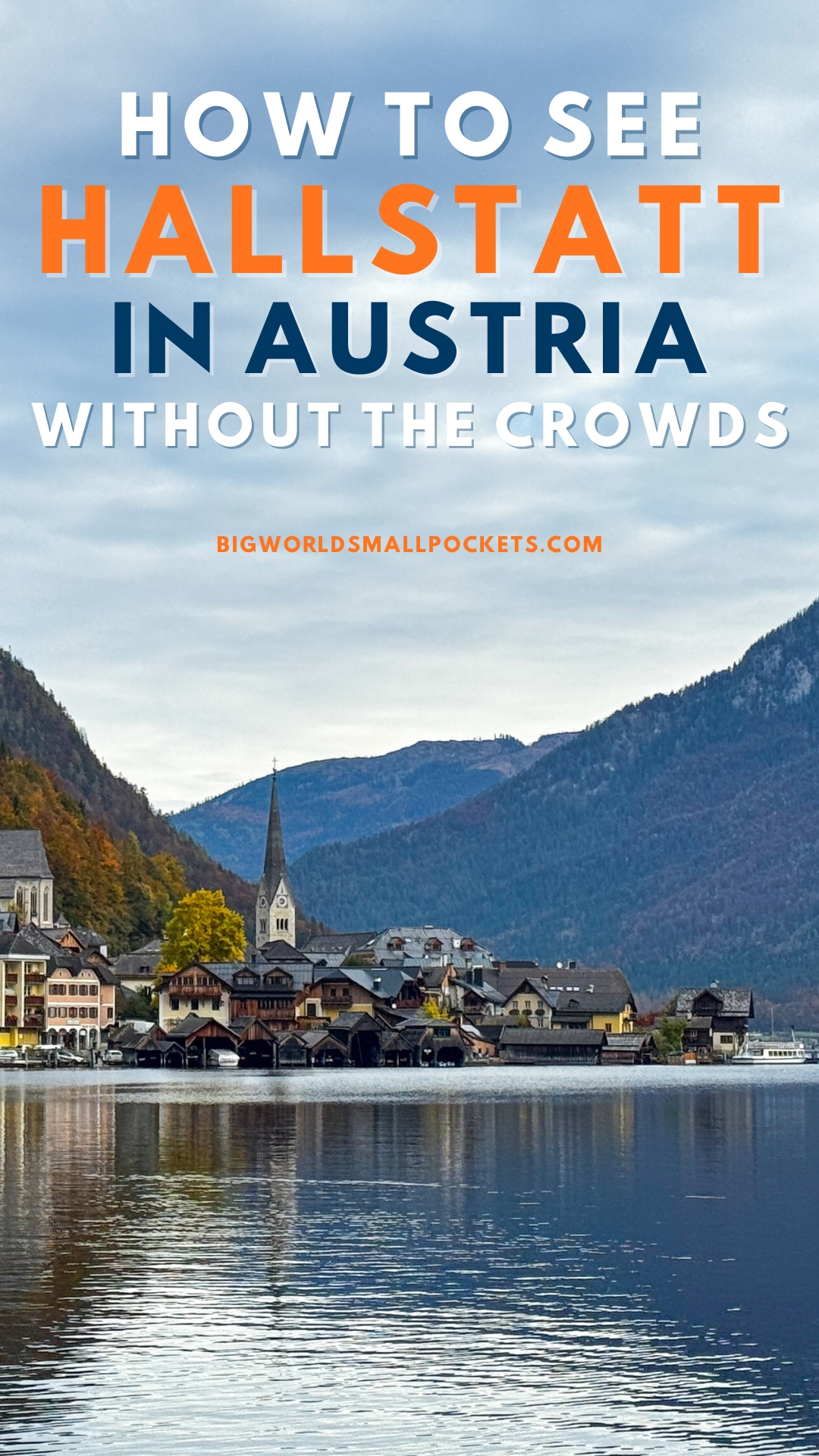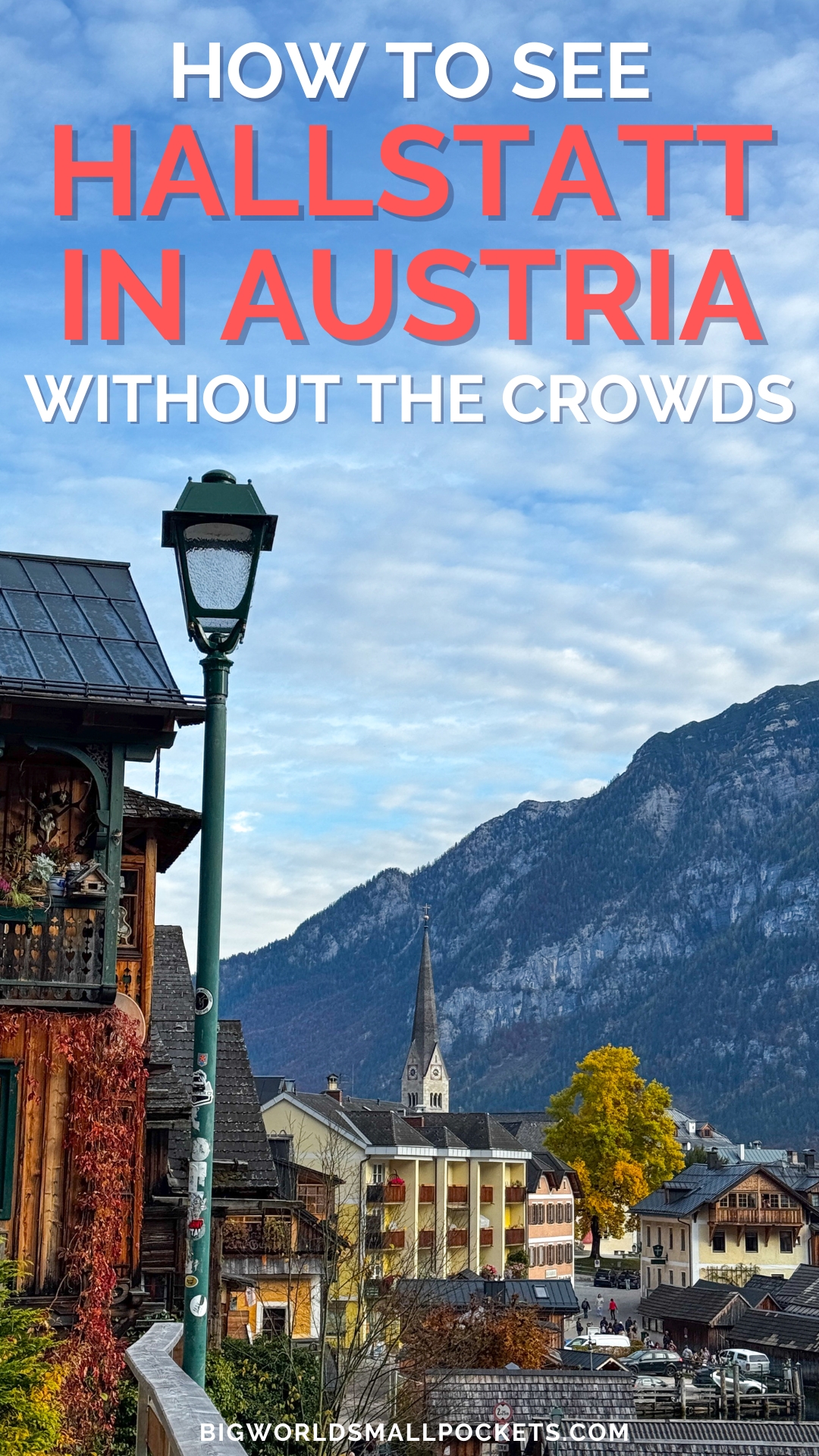When I first saw pictures of Hallstatt online, I genuinely wondered if it was real.
A tiny alpine village pressed between mountains and a glassy lake, with pastel houses tumbling down to the water and church spires perfectly reflected on its surface – it looked like ideal Instagram fodder.
So when I finally found myself travelling through Upper Austria one crisp autumn, I knew I had to go.
What I didn’t realise, though, was how many others had the same idea!
Around 20,000 people visit Hallstatt every day in peak season, which is quite something for a village with a population of just 700 locals.
It’s no wonder residents have politely asked for fewer tour buses and more mindful tourism.
Still, with a bit of planning, you absolutely can experience the magic of Hallstatt without the crowds. Here’s how I did it, and you can too…
Related Posts
- 3 Day Itinerary for Salzburg and Austrian Lakes
- 10 Hidden Gems in Vienna
- How to Travel from Salzburg to Vienna
Visit Mid-Week and Off-Season
Timing is everything when it comes to primetime Hallstatt.
Most visitors head to this picturesque village between late May and early September, and weekends are the busiest.
Bucking the trend, I visited in October, and honestly, it was perfect.
The autumn colours were blazing across the mountains, the air was crisp, and there was just enough life in the village to feel lively but not chaotic.
If you can, travel mid-week, ideally Tuesday to Thursday.
The difference between a Wednesday morning and a Saturday afternoon in Hallstatt is night and day.
Locals told me they actually plan errands around the weekend crowds – that’s how intense it gets!
Visiting in autumn, or even early spring, also means better prices on accommodation, easier restaurant reservations, and more room to breathe when taking photos.
Stay Overnight Nearby
Most people rush through Hallstatt on a coach tour, spending a frantic two hours trying to cram in all the views.
Don’t be that traveller.
Stay overnight – either in Hallstatt itself (if you can find a spot) or in one of the lovely (and cheaper) neighbouring towns like Bad Goisern or Bad Ischl.
I stayed in Bad Goisern, about 15 minutes away, and it was such a great decision.
My accommodation choice, Hotel Goiserermühle, had views of the Dachstein mountains, and the owners served incredible homemade preserves and pickles with breakfast.
Bad Ischl, meanwhile, is a slightly larger spa town with a bit more buzz – think elegant architecture, cafés with Sachertorte, and a royal connection to Emperor Franz Joseph.
Staying there, at the Grand Elisabeth Hotel, also means you can combine Hallstatt with other scenic spots like Gosausee or the salt mines nearby.
From both towns, it’s an easy hop on the local bus #542 or #543 to Hallstatt early in the morning before the tour groups arrive.
Arrive Early for a Peaceful Morning
Even in the quieter months, Hallstatt starts to get busy by late morning.
The sweet spot is arriving around 8 or 9am, when the lake is still misty and the streets are silent except for the sound of church bells.
I grabbed a takeaway coffee from a lakeside café and wandered down to the viewpoint where the classic postcard shot is taken – you know, the one that’s plastered across Instagram.
At that hour, there were maybe two other people there, who smiled at me in the mutual understanding of “wow, we made it before the chaos”.
By 11am, I walked back past the same spot, and there were easily fifty people jostling for selfies.
The early bird definitely gets the best reflection photos here.
Arrive by Bus or Ferry, Not a Coach Tour
The key to keeping your visit relaxed is avoiding the huge coach tours that roll in mid-morning.
Instead, take public transport.
From Salzburg, first travel direct to Bad Ischl or Bad Goisern.
From there it’s straightforward: hop on Bus #542 or #543 to Hallstatt.
Check out the journey planner for regional bus company OOEVV for up to date timetables.
The buses are clean, efficient, and usually filled with locals or independent travellers rather than crowds.
Tickets can be bought onboard from the driver using cash or card and you’ll arrive right at the end of the main village street.
Alternatively, you can take the train to Hallstatt station, which is located on the opposite side of the lake from the village.
From there, hop on the ferry across to the village.
It’s a short, scenic ride, and honestly one of the best first glimpses you can get of Hallstatt – the village slowly appearing like a painting as you glide over the water.
I did the ferry route on the way back, and it was magical.
The water was so still it looked like polished glass, and a small rainbow arched over the mountains. Pure alpine drama.
Ferries run year round, although there is a reduced service in the winter months – see the ferry timetable for more info.
Explore Beyond the Main Street
Most people never stray from the main lakefront strip in Hallstatt, which means you can easily find quiet corners if you just wander uphill.
I took the narrow alleys behind the main street and found a cluster of traditional wooden houses with flower boxes still blooming.
Cats lounged on doorsteps, and a local man was hanging laundry with the kind of mountain view you’d pay a fortune for in a hotel.
From there, I continued to the Skywalk, a viewing platform high above the village.
It’s a bit of a climb, but the views are extraordinary with Hallstatt and the lake spread out like a storybook illustration.
You can also take the funicular if you’d rather save your legs.
Don’t miss the Charnel House either – a fascination glimpse into the after-life process kept up in the village – and, if you have time, pop into the Hallstatt Salt Mine (Salzwelten), the oldest in the world.
The history of the town is deeply tied to salt mining, and the tour takes you inside the mountain itself – a fascinating glimpse into how this tiny place became so significant.
Travel Respectfully and Sustainably
Because Hallstatt is so small, it really feels the impact of tourism.
Be kind to locals by keeping noise down, not blocking narrow lanes for photos, and always asking before photographing people or private homes.
Many restaurants are family-run, so try to eat locally – places like Gasthof Zauner or Bräugasthof Hallstatt serve hearty Austrian dishes and regional wine in cosy settings.
And remember to bring euros cash, as not every café accepts cards.
Hallstatt’s charm lies in its tranquillity, so slowing down and being mindful not only improves your experience, but also helps the community preserve that magic too.
When to Go and How Long to Stay
If you’re building Hallstatt into a wider Austria itinerary.
Plan to stay in or near the village for least one night.
You can easily pair Hallstatt with additional nights in nearby Salzburg, or near the Dachstein glacier, or lakes around Gosau.
For the best Hallstatt experience, aim for…
- October or early November for autumn colours or April or early May for blossoms and fewer crowds
- Mid-week visits for more peaceful days
- Early mornings for better photos
PIN IT TO PINTEREST!
Hallstatt is every bit as beautiful as it looks in photos, but it’s also a living village, not a movie set.
Travelling slowly, choosing off-peak times, and using local transport makes your experience not only more enjoyable, but also more sustainable for the community that calls this place home.
Standing on the lakefront at dawn, with the mountains mirrored perfectly in the still water, I finally understood why so many people fall in love with Hallstatt.
It’s not about ticking it off a list.
It’s about finding that moment of peace in a place that’s quietly endured centuries – and learning to see it as the locals do.
My Austria trip was gifted by Visit Salzburgerland and Upper Austria Tourism but, as always, all views are my own.
This page contains affiliate links meaning Big World Small Pockets may receive a small commission on any purchases at no extra cost to you.
Just enter your details below and I'll email it you - simple!
Information will be sent to the email provided above

